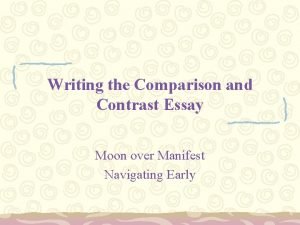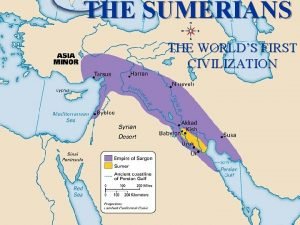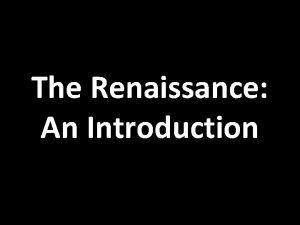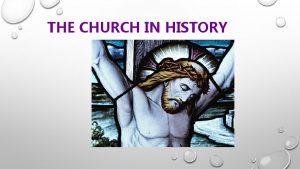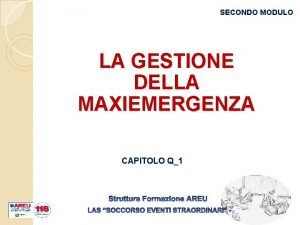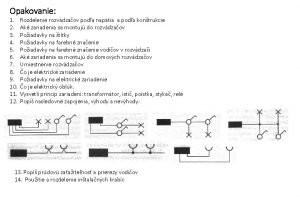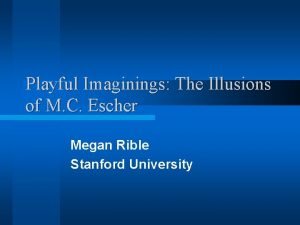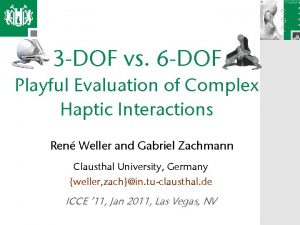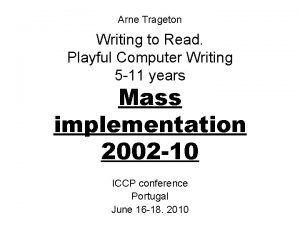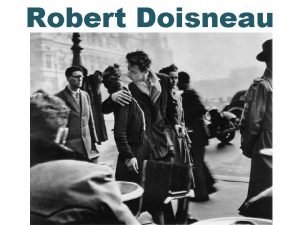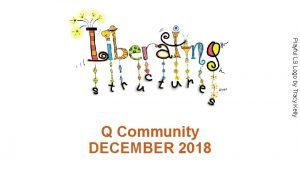The start of A Study of Willys Playful




























































































































- Slides: 124

The start of: A Study of Willy’s Playful Pictures by Anthony Browne

Jan van Eyck 1395 -1441

Jan van Eyck was a Flemish painter, active in Bruges, who along with Robert Campin (previously known only as the Master of Flémalle) in Tournai, was the founder of the Ars Nova (“new art”) of 15 th-century northern late Gothic painting. This style heralded the Renaissance in northern Europe. This period of Netherlands art is characterized by a naturalistic style of vivid oil colors, meticulous detail, accurately rendered textures, and the illusion of three-dimensional space on a two-dimensional surface.

Nine paintings by Jan are still extant, carefully signed and dated, all between 1432 and 1439. Of these pictures, four depict religious subjects—including the Madonna with Canon van der Paele (1436, Groeninge Museum, Bruges)—and five are portraits, such as Giovanni Arnolfini and His Wife (1434, National Gallery, London).

The Arnolfini Marriage (1434) oil on panel (1435)National Gallery, (1436) ondon. L

The Madonna of Canon van der Paele (1436) oil on panel, Musée Communal at Bruges.

Jan's contemporaries were awed by his amazing technical skill and his precise renderings of carefully observed detail. These qualities explain why he was still called the King of Painters by his compatriots as late as the 16 th century.

Sandro Botticelli 1445 -1510

Sandro Botticelli, born Alessandro di Mariano Filipepi, is considered one of the leading painters of the Florentine Renaissance. He developed a highly personal style characterized by elegant execution, a sense of melancholy, and a strong emphasis on line; details appear as sumptuous still lifes.

Botticelli was born in Florence, the son of a tanner. His nickname was derived from Botticello (“little barrel”), either the nickname of his elder brother or the name of the goldsmith to whom Sandro was first apprenticed. Later he served an apprenticeship with the painter Fra Filippo Lippi and also worked with the painter and engraver Antonio del Pollaiuolo, from whom he gained his sense of line; he was also influenced by Andrea del Verrocchio.

Botticelli had his own workshop by 1470. He spent almost all of his life working for the great families of Florence, especially the Medici family, for whom he painted portraits. Botticelli also painted religious subjects, and in 1481, he was one of several artists chosen to go to Rome to decorate the walls of the Sistine Chapel in the Vatican.

The Birth of Venus (1485) Galleria degli Uffizi, Florence Tempera on canvas 172. 5 x 278. 5 cm

Venus (detail)

Georges Seurat 1859 -1891 “Art is Harmony is the analogy of contrary and similar elements of tone, of color, and of line, considered according to their dominants and under the influence of light, in gay, calm, or sad combinations. . Gaiety of tone is given by the luminous dominant; of color, by the warm dominant; of line, by lines above the horizontal. ”

Born in Paris, Seurat was strongly influenced in his youth by the works of Dutch realist Rembrandt and the Spaniard Goya. Seurat studied art for a year at the Ecole des Beaux-Arts under Lehmann, a former pupil of Ingres. Also influenced by the Impressionists and Delacroix, Seurat was interested in theories of vision and color.

Seurat's name is forever affiliated with Pointillism, the nineteenth-century French school of Post-Impressionism that he founded. By meticulously applying various degrees of colored “dots” to the canvas, Pointillism produced the impression of changes in light.

Paul Gauguin mockingly described such work as “painted fleas, ” yet these dots of color, usually applied next to a complementary pigment (reds next to greens, blues next to oranges), render stunning, shimmering images. This system of painting underlies without dominating much of Seurat's landscape and figure work.

“They see poetry in what I have done. No. I apply my method, and that is all there is to it. ” --Seurat

This scene, with over forty figures and their surroundings, took the artist almost two years to complete, during which he refused to lunch with close friends lest they distract him from his work. Today it remains his best-known masterpiece and a monument to dedication. Sunday Afternoon on the Island of La Grande Jatte (1884 -1886) is one of only seven large pictures executed by Seurat during his short life.

He said of modern life that he wanted to decipher it with the feeling of the frieze of the Parthenon; some of the classical quality of that sculpture is embodied in Seurat's portrayals of the life around him. Seurat’s educational influences included drawing lessons from the sculptor Justin Lequien.

Michelangelo Buonarroti 1475 -1574

Michelangelo is one of the most inspired creators in the history of art and, with Leonardo da Vinci, the most potent force in the Italian High Renaissance. As a sculptor, architect, painter, and poet, he exerted a tremendous influence on his contemporaries and on subsequent Western art in general.

Michelangelo's father, a Florentine official named Ludovico Buonarroti with connections to the ruling Medici family, placed his 13 -year-old son in the workshop of the painter Domenico Ghirlandaio. After about two years, Michelangelo studied at the sculpture school in the Medici gardens and shortly thereafter was invited into the household of Lorenzo de' Medici, the Magnificent.

There he had an opportunity to converse with the younger Medicis, two of whom later became popes (Leo X and Clement VII). He also became acquainted with such humanists as Marsilio Ficino and the poet Angelo Poliziano, who were frequent visitors. Michelangelo produced at least two relief sculptures by the time he was 16 years old, the Battle of the Centaurs and the Madonna of the Stairs (both 1489 -92, Casa Buonarroti, Florence), which show that he had achieved a personal style at a very early age.

His patron Lorenzo died in 1492; two years later Michelangelo fled Florence, when the Medici were temporarily expelled. He settled for a time in Bologna, where in 1494 and 1495 he executed several marble statuettes for the Arca (Shrine) di San Domenico in the Church of San Domenico.

Michelangelo then went to Rome, where he was able to examine many newly unearthed classical statues and ruins. He soon produced his first large-scale sculpture, the over-life-size Bacchus (1496 -98, Bargello, Florence). One of the few works of pagan rather than Christian subject matter made by the master, it rivaled ancient statuary, the highest mark of admiration in Renaissance Rome.

The high point of Michelangelo's early style is the gigantic (4. 34 m/14. 24 ft) marble David (Accademia, Florence), which he produced between 1501 and 1504, after returning to Florence. The Old Testament hero is depicted by Michelangelo as a lithe nude youth, muscular and alert, looking off into the distance as if sizing up the enemy Goliath, whom he has not yet encountered.

The fiery intensity of David's facial expression is termed terribilità, a feature characteristicof many of Michelangelo's figures and of his own personality. David, Michelangelo's most famous sculpture, became the symbol of Florence and originally was placed in the Piazza della Signoria in front of the Palazzo Vecchio, the Florentine town hall. With this statue Michelangelo proved to his contemporaries that he not only surpassed all The fiery intensity of David's facial expression is termed terribilità, a feature characteristic modern artists, but also the Greeks and Romans, by infusing formal beauty with powerful expressiveness and meaning.

Michelangelo was recalled to Rome by Pope Julius II in 1505 for two commissions. The most important one was for the frescoes of the Sistine Chapel ceiling. Working high above the chapel floor, lying on his back on scaffolding, Michelangelo painted, between 1508 and 1512, some of the finest pictorial images of all time. On the vault of the papal chapel, he devised an intricate system of decoration that included nine scenes from the Book of Genesis.

These scenes begin with God Separating Light from Darkness and include the Creation of Adam, the Creation of Eve, the Temptation and Fall of Adam and Eve, and the Flood. Centrally located, these narratives are surrounded by alternating images of prophets and sibyls on marble thrones, by other Old Testament subjects, and by the ancestors of Christ. In order to prepare for this enormous work, Michelangelo drew numerous figure studies and cartoons, devising scores of figure types and poses. These awesome, mighty images, demonstrating Michelangelo's masterly understanding of human anatomy and movement, changed the course of painting in the West.

Creation of Adam (1510) Fresco, 280 x 570 cm Cappella Sistina, Vatican

Leonardo de Vinci 1452 -1519 Leonardo da Vinci was a Florentine artist, one of the great masters of the High Renaissance, who was also celebrated as a painter, sculpor, architect, engineer, and scientist.

His profound love of knowledge and research was the keynote of both his artistic and scientific endeavors. His innovations in the field of painting influenced the course of Italian art for more than a century after his death, and his scientific studies—particularly in the fields of anatomy, optics, and hydraulics—anticipated many of the developments of modern science.

Leonardo was born on April 15, 1452, in the small Tuscan town of Vinci, near Florence. He was the son of a wealthy Florentine notary and a peasant woman. In the mid-1460 s the family settled in Florence, where Leonardo was given the best education that Florence, the intellectual and artistic center of Italy, could offer. He rapidly advanced socially and intellectually. He was handsome, persuasive in conversation, and a fine musician and improviser.

About 1466 he was apprenticed as a garzone (studio boy) to Andrea del Verrocchio, the leading Florentine painter and sculptor of his day. In Verrocchio's workshop Leonardo was introduced to many activities, from the painting of altarpieces and panel pictures to the creation of large sculptural projects in marble and bronze. In 1472 he was entered in the painter's guild of Florence, and in 1476 he is still mentioned as Verrocchio's assistant.

About 1482 Leonardo entered the service of the duke of Milan, Ludovico Sforza, having written the duke an astonishing letter in which he stated that he could build portable bridges; that he knew the techniques of constructing bombardments and of making cannons; that he could build ships as well as armored vehicles, catapults, and other war machines; and that he could execute sculpture in marble, bronze, and clay.

He served as principal engineer in the duke's numerous military enterprises and was active also as an architect. In addition, he assisted the Italian mathematician Luca Pacioli in the celebrated work Divina Proportione (1509). Evidence indicates that Leonardo had apprentices and pupils in Milan, for whom he probably wrote the various texts later compiled as Treatise on Painting (1651; trans 1956).

One of the most celebrated portraits ever painted, it is also known as La Gioconda, af the presumed name of the woman's husban Leonardo seems to have had a special affection for the picture, for he took it with him on all of his subsequent travels.

Mona Lisa (La Gioconda) ( c. 1503 -5) Oil on panel 77 x 53 cm Musée du Louvre, Paris

Jean-Francois Millet 1814 -1875 French painter, etcher and draughtsman associated with the Barbizon school, his later works were criticized for expressing socialist ideas.

Jean-François Millet, who settled in Barbizon late in 1849, was born into a farming family. Trained with an academic painter in Paris, Millet devoted his early work to portraits and erotic nudes. He was sensitive to the changes brought about by the increasing urbanization and industrialization of France, and he was particularly inspired by the social issues raised by the Revolution of 1848. Thereafter he turned to scenes of peasants laboring, endowing them with heroic form adapted from the art of the past.

Unprecedented in French art, such works by Millet as The Sower were particularly controversial in the political climate of the time. Powerful and monumental, Millet's sower strides across a newly plowed field with energy and resolution, scattering the seeds for a new crop; he serves as an emblem of regeneration and of the elemental relationship between man and nature. Crude in appearance, the work provoked commentary not only on its subject matter but also on its styles and unorthodox technique.

Political conservatives, who viewed the peasants as a potentially disruptive social element, attacked Millet, while liberals praised his ennoblement of rural life. The Gleaners

The Gleaners (1857) A nostalgia for an existence that was a dying phenomenon eventually made Millet's works some of the most famous images of their day. His paintings were exhibited widely on both sides of the Atlantic.

Nicolas Poussin


Frida Kahlo


Winslow Homer


Edward Hopper


Antonio Polliauolo 1431(? )-1498 Pollaiuolo, surname of two Italian artists of the Renaissance, who, as brothers, shared a busy workshop in Florence. Patronized by the Medici family, the firm produced articles of gold, bronze sculpture, paintings, and decorative work.

A painter, sculptor, goldsmith, and engraver, his real name was Antonio di Jacopo d'Antonio Benci. A painter, Piero did three of the paintings known as the Seven Virtues (1469 -1470, Uffizi, Florence), and probably collaborated with Antonio on three others.

Apollo and Daphne Tempera on wood 30 x 20 cm National Gallery, London

Pieter Brueghel the Elder 1525 -1569 Pieter Bruegel the Elder (byname Peasant Bruegel, also spelled Brueghel or Breughel), the greatest Flemish painter of the 16 th century, whose landscapes and vigorous, often witty scenes of peasant life are particularly renowned. He spelled his name Brueghel until 1559, and his sons retained the "h" in the spelling of their names.

Since Bruegel signed and dated many of his works, his artistic evolution can be traced from the early landscapes, in which he shows affinity with the Flemish 16 thcentury landscape tradition, to his last works, which are Italianate. He exerted a strong influence on painting in the Low Countries, and through his sons Jan and Pieter he became the ancestor of a dynasty of painters that survived into the 18 th century.

In 1551 or 1552, Bruegel set off on the customary northern artist's journey to Italy, probably by way of France. From several extant paintings, drawings, and etchings, it can be deduced that he traveled beyond Naples to Sicily, possibly as far as Palermo, and that in 1553 he lived for some time in Rome, where he worked with a celebrated miniaturist, Giulio Clovio, an artist greatly influenced by Michelangelo and later a patron of the young El Greco.

The earliest surviving works, including two drawings with Italian scenery sketched on the southward journey and dated 1552, are landscapes. A number of drawings of Alpine regions, produced between 1553 and 1556, indicate the great impact of the mountain experience on this man from the Low Countries. With the possible exception of a drawing of a mountain valley by Leonardo da Vinci, the landscapes resulting from this journey are almost without parallel in European art for their rendering of the overpowering grandeur of the high mountains.

Very few of the drawings were done on the spot, and several were done after Bruegel's return, at an unknown date, to Antwerp. The vast majority are free compositions, combinations of motifs sketched on the journey through the Alps. Some were intended as designs for engravings commissioned by Hiëronymus Cock, an engraver and Antwerp's foremost publisher of prints.

The paintings that Bruegel produced in increasing number after his return from Italy carried a double interest in landscape and in subjects requiring the representation of human figures. All of his paintings, even those in which the landscape appears as the dominant feature, have some narrative content. Conversely, in those that are primarily narrative, the landscape setting often carries part of the meaning. Dated paintings have survived from each year of the period except for 1558 and 1561.

The Rotterdam Tower of Babel illustrates an obsessive interest in rendering movement, a characteristic of Bruegel's art. It was a problem with which he constantly experimented. In the Rotterdam painting, movement is imparted to an inanimate object, the tower seeming to be shown in rotation.

The Tower of Babel 1563) ( O il on oak panel, 114 x 155 cm K unsthistoris ches Museum, Vienna

Raphael was an Italian Renaissance painter who is considered one of the greatest and most popular artists of all time. 1483 -1520

Raphael was born Raffaello Sanzio or Raffaello Santi in Urbino on April 6, 1483, and received his early training in art from his father, the painter Giovanni Santi. According to many art historians, he also studied with Timoteo Viti at Urbino, executing under his influence a number of works of miniaturelike delicacy and poetic atmosphere.

In 1504 Raphael moved to Florence, where he studied the work of such established painters of the time as Leonardo da Vinci, Michelangelo, and Fra Bartolommeo, learning their methods of representing the play of light and shade, anatomy, and dramatic action. At this time he made a transition from the typical style of the Umbrian school, with its emphasis on perspective and rigidly geometrical composition, to a more animated, informal manner of painting.

St. George Fighting the Dragon (1504 -06) Oil on wood 28. 5 x 21. 5 cm National Gallery of Art Washington

Jan Vermeer


Dominique Ingres 1780 -1867 Academic and controlled, Jean-Auguste. Dominique Ingres was a leading figure in the neo-classical movement of the 19 th century.

Born in Montauban on 29 August, 1780, the son of an unsuccessful sculptor and painter, Ingres studied at the art academy in Toulouse before joining the studio of Jacques-Louis David in 1797. Ingres, who was David's best student, began his career in obscurity. Though he personally disliked the Academy and avoided the Salon, Ingres has come to be identified with its goals and viewed as an artistic conservative. But, despite his allegiance to clear and precise form, balanced compositions, and idealized beauty, he shared much of the same interest in exotic and erotic subject matter that had attracted the Romantics.

Ingres was a sensitive and painstaking draftsman. For him, drawing was the very heart of painting, and he drew and redrew whatever he was to paint until he understood all its elements and their subtlest interrelations. Though he valued history painting above all else, he also often produced portraits, some of the best of which are drawings. Ingres's outstanding evocation of place, light, and character in these seemingly casual portrait drawings established him as one of the most revered draftsmen in art history.

Ingres exhibited a sensual feeling in his works that was more often expressed in the nudes that preoccupied him as he got older and his style developed. His Turkish Women at the Bath, produced at 82 years of age, is the culmination of his portrayals of female nudes. Even in life he was enthusiastically recognized as one of the greatest painters in France. His reputation was established and his works commanded high prices. He was given the rank of commander of the Legion of Honour in 1845. At the Universal Exhibition of Paris in 1855 he was awarded a gold medal (as was Delacroix, leader of the Romantic Movement).

Raphael and the Fornarina (1814) Fogg Art Museum at Harvard University

Odalisque with a Slave (1842) Walters Art Gallery Baltimore, MD

Gustave Caillebotte 1848 -1894 French painter and a generous patron of the impressionists, whose own works, until recently, were neglected.

Both a painter and collector, Caillebotte inherited a fortune at the age of twenty-five, enabling him to dedicate himself to painting, to give financial help to his impressionist friends, and to buy many of their works. Photo: 1878

As an artist, Caillebotte was very interested in the blending of water and vegetation. Varying the point of view in his different works dedicated to the subject, he was especially interested in watching the passage of time and of the seasons in order to study the differences in light. In so doing, he developed the traits essential to impressionism, through a style close to that of Renoir and of Bazille.


Aert de Gelder 1645 -1727 Also known as Arent Jansz de Gelder, Aert de Gelder built a career practicing Rembrandt van Rijn's style. From 1661 to 1663 De Gelder was one of Rembrandt's last students in Amsterdam. He returned to his native Dordrecht in Holland, but the experience was unforgettable.

Painting principally biblical subjects and portraits, de Gelder retained Rembrandt's naturalness, sympathy, and human warmth Like those of his master, de Gelder's Old Testament scenes display strong, warm color; Oriental types and costumes; and interest in the scenes’ human aspect.

Self-Portrait as Greek painter Zeuxis. Legend has it that Zeuxis died laughing while painting a funnylooking old woman.

To vary textures, de Gelder applied paint with his thumb, fingers, and palette knife. He also scraped and scratched into the wet paint with the butt end of his brush, a technique he probably learned from. Rembrandt. Over time, de Gelder gave Rembrandt's palette a Rococo flavor by lightening it and using pinks and violets.

Edouard Manet 1832 -1883 French Realist/Impressionist Painter Manet adopted a realist approach and contended that design is more important than subject matter.

Realism is an approach to art in which subjects are portrayed in as straightforward manner as possible, without idealizing them and without following the rules of formal theory. The earliest Realist work began to appear in the 18 th century, as a reaction against the excesses of Romanticism and Neoclassicism, but the great Realist era was the mid-19 th century, as artists became disillusioned with the Salon system and the influence of the Academies.

It seems as if each one of the great 19 th century French painters was initially forbidden by his respectable parents to entertain ambitions of being an artist but won them over, or wore them down, by failing to succeed at any of the respectable professions they endorsed. Manet's parents (well-educated and distinguished middle class Parisians - his father a high official in the Ministry of Justice, his mother the daughter of a diplomat) were no different. But they finally gave their consent to their son's vocation if he studied with a respectable art teacher. He chose Thomas Couture and worked under him for six years.

Manet always sought to be accepted by the Salon and refused to exhibit with his Impressionist friends. After touring the museums of Europe, Manet found himself befriended by the two most advanced Parisian writers of the time, the novelist and social critic Émile Zola, and the poet and art critic Charles Baudelaire.

Through Zola and Boudelaire he was influenced to study the works of Socrates, whose seminar room was the streets of Athens and who lived on the surplus of his very wealthy friends, and Plato's Symposium, perhaps the greatest of the dialogues, wherein drinking and speechmaking lead to philosophizing about the most private and profound of all matters, love. . . But this kind of high-spirited joke at the expense of the rules and rigidity of the Academy was the essence of the young Manet's elegant and unconventional vision.

In the next few years, Manet produced two works involving contemporary female nudes with which his name will forever be identified: The Picnic on the Grass (Le Déjeuner sur l'herbe) (1863) and Olympia (1865). Nudes were a respected subject for the academy as long as they were idealized, and both of these works were based on Renaissance compositions.


Picnic combines some river gods from a lost Raphael design of The Judgment of Paris (known from Marcantonio Raimondi's engraving based on the work), combined with the three seated figures from the Giorgione. Titian Concert Champêtre. Here we see him taking his figures from the Renaissance masters, but rather than idealizing them he paints people he knew. Why Manet felt the need to refer to such complex High Renaissance templates when painting his contemporary Paris and has never been satisfactorily explained.

But neither contemporary audiences nor critics knew as much as Manet about the history of painting, and since he avoided explicit remarks about his intentions throughout his career, the paintings were viewed as the work of an incompetent and ignorant artist who outraged decency and decorum. The blatant nudity and frank, confrontational stare of the female model in both paintings was an occasion for hypocritical shock among prurient French middle class males themselves frequent patrons of just such women.

Francisco de Goya 1746 -1828 Francisco José de Goya Y Lucientes, known as Goya, was one of the earliest artists to see beneath the facade of rationality and expose the mind as the seat of irrationality.

From the Spanish Rococo Era, de Goya was a Romantic Painter and Printmaker. The Rococo style succeeded Baroque Art in Europe. It was centered in France, and is generally associated with the reign of King Louis XV (1715 -1774). It is a light, elaborate and decorative style of art.

Francisco de Goya is one of the great Spanish masters, initially trained in then-current Rococo style. He gradually developed his own distinctive style of painting, showing the influence of Velázquez and Rembrandt. Goya's late works became quite dark in mood, from his satirical caricatures to the so-called Black Paintings such as Saturn Devouring One of his Sons.

Rococo was eventually replaced by Neoclassicism, which was the popular style of the American and French revolutions. Romanticism might best be described as anti-Classicism, as it was a reaction against Neoclassicism. It is a deeply-felt style which is individualistic, beautiful, exotic, and emotionally wrought.

Although Romanticism and Neoclassicism were philosophically opposed, they were the dominant European styles for generations, and many artists were affected to a greater or lesser degree by both. Artists might work in both styles at different times or even mix the styles, creating an intellectually Romantic work using a Neoclassical visual style.

“Saturn Devouring one of his Sons” depicts a mythological themeabout the god Saturn or Cronos- acting as an allegorical representation of time. The god devours, as time does to all that it creates: he feared that one of the children born to his wife Cibele would dethrone him.

For the bold technique of his paintings, the haunting satire of his etchings, and his belief that the artist's vision is more important than tradition, Goya is often called “the first of the moderns. ” His uncompromising portrayal of his times marks the beginning of 19 th-century realism. A serious illness in 1792 left Goya permanently deaf. Isolated from others by his deafness, he became increasingly occupied with the fantasies and inventions of his imagination and with critical and satirical observations of mankind. He evolved a bold, free new style close to caricature.

The Dog 1820 -1823 134 x 80 cm Oil on plaster remounted on canvas Museo del Prado, Madrid


Caspar David Friedrich 1744 -1840 Many of his pictures, as one learns to read them, offer views into the distance that are also paths through life. - Lawrence Gowing, Paintings in the Louvre

This German Romantic painter was one of the greatest exponents in European art of the symbolic landscape. He studied at the Academy in Copenhagen (1794 -98), and subsequently settled in Dresden, often traveling to other parts of Germany. Friedrich's landscapes reflect those of northern Germany and are beautiful renderings of trees, hills, harbors, morning mists, and other light effects based on a close observation of nature.

Romanticism was an early nineteenthcentury aesthetic movement encompassing nature, nationalism, and spirituality. In Germany, it found perfect expression in the music of Beethoven, the writings of Goethe, and the art of Caspar David Friedrich. The transience of human existence, the redemptive powers of nature, man at the mercy of the elements – all are stock themes of Romanticism.

Friedrich is often compared to his contemporaries, the landscape painters Turner and Constable. But his paintings are not intended as landscapes; Friedrich never painted from nature. He traveled throughout northern Europe and made detailed sketches of its terrain, but his paintings contain elements of different settings in wholly imagined scenes. Friedrich actually ignores the law of nature for aesthetic impact.

In his paintings Friedrich rarely depicts people, except to emphasize nature's vastness. When figures appear in his paintings, they stand with their backs to the viewer, lost in contemplation. Friedrich is primarily a religious artist. The Romantic worship of nature finds literal expression in his work, which articulates the artist's Protestant faith through natural symbolism. On a sensual level, his paintings deliver a frisson of ecstasy or horror. But they also demand intellectual decoding.

For Friedrich, they also had personal meaning. At 13, Friedrich fell through the surface of a frozen lake and nearly perished. His brother saved Friedrich's life but drowned in the effort. Friedrich's mother died in 1781, and a sister ten years later. His dark, deeply religious paintings may reflect these childhood tragedies.

Some of Friedrich's best-known paintings are expressions of a religious mysticism, while other apparently nonsymbolic paintings contain inner meanings, clues to which are provided either by the artist's writings or those of his literary friends. Today, Friedrich is recognized as the quintessential German Romantic painter. In his lifetime, though, he achieved only modest fame, and his talent was cheapened by imitation.

Friedrich remained shrouded in obscurity until the 1890 s, when he was rediscovered by the Symbolists. In 1945, fire gutted the National Gallery, Berlin, destroying many of his masterpieces. The scarcity of Friedrich's paintings heightens their emotive power today.

Evening (1824) Gemäldegalerie, Dresden “The divine is everywhere, even in a grain of sand. ” Caspar David Friedrich

William Blake 1757 -1827 “The man who never alters his opinion is like standing water, and breeds reptiles of the mind. ” - The Marriage of Heaven and Hell

Blake was born in London on 28 November, 1757. Following his seven-year apprenticeship to an engraver (Basir), Blake attended the Royal Academy. In 1784 he set up a printshop with James Parker at 27 Broad Street. For the rest of his life Blake eked out a living as an engraver and illustrator, aided by his wife. Blake's most popular poems are found in his Songs of Innocence (1789), eloquent lyrics that make fresh, direct observations. In 1794, disillusioned with the possibility of human perfection, Blake issued Songs of Experience. Both series of poems take on a deeper resonance when read in conjunction.

PIPING down the valleys wild, Piping songs of pleasant glee, On a cloud I saw a child, And he laughing said to me: Reeds of Innocence by William Blake 'Pipe a song about a Lamb!' So I piped with merry cheer. 'Piper, pipe that song again; ' So I piped: he wept to hear. 'Drop thy pipe, thy happy pipe; Sing thy songs of happy cheer!' So I sung the same again, While he wept with joy to hear.

'Piper, sit thee down and write In a book that all may read. ' So he vanish'd from my sight; And I pluck'd a hollow reed, And I made a rural pen, And I stain'd the water clear, And I wrote my happy songs Every child may joy to hear. Glad Day Painted by William Blake (1794)

O THOU with dewy locks, who lookest down Through the clear windows of the morning, turn Thine angel eyes upon our western isle, Which in full choir hails thy approach, O Spring! TO SPRING By William Blake The hills tell one another, and the listening Valleys hear; all our longing eyes are turn'd Up to thy bright pavilions: issue forth And let thy holy feet visit our clime! Come o'er the eastern hills, and let our winds Kiss thy perfumèd garments; let us taste Thy morn and evening breath; scatter thy pearls Upon our lovesick land that mourns for thee. O deck her forth with thy fair fingers; pour Thy soft kisses on her bosom; and put Thy golden crown upon her languish'd head, Whose modest tresses are bound up for thee.

Never seek to tell thy love, Love that never told can be; For the gentle wind doth move Silently, invisibly. LOVE’S SECRET By William Blake I told my love, I told her all my heart, Trembling, cold, in ghastly fears : Ah! She did depart. Soon after she was gone from me A traveler came by, Silently, invisibly: He took her with a sigh.

Blake illustrated Songs and other works with designs that demand an imaginative reading of the dialogue between word and picture. Most likely, he created his illustrations by writing the words and drawing the pictures for each poem on a copper plate; then, by applying some liquid impervious to acid, the text and illustration were left in relief. Ink or a color wash was then applied, and the printed picture was finished by hand in watercolors.

Blake has been called a pre-romantic because he rejected neo-classical literary style and modes of thought. His graphic art also defied 18 thcentury conventions. Always stressing imagination over reason, he felt that ideal forms should be constructed not from observations of nature but from inner visions.

In his Prophetic Books, a series of longer poems written from 1789 on, Blake created a complex personal mythology and invented his own symbolic characters to reflect his nonconformist radical social and political concerns. This is the context of Glad Day.

Henri Rousseau


Vincent Van Gogh


Special Thanks to: Hearts-Ease. org, © 1998 Microsoft® Encarta '97 Web Gallery of Art http: //www. kfki. hu/~arthp/index 1. html
 Raffaello willys
Raffaello willys Half playful half serious
Half playful half serious But we gotta start somewhere
But we gotta start somewhere Triage start
Triage start Hát kết hợp bộ gõ cơ thể
Hát kết hợp bộ gõ cơ thể Frameset trong html5
Frameset trong html5 Bổ thể
Bổ thể Tỉ lệ cơ thể trẻ em
Tỉ lệ cơ thể trẻ em Voi kéo gỗ như thế nào
Voi kéo gỗ như thế nào Chụp tư thế worms-breton
Chụp tư thế worms-breton Chúa sống lại
Chúa sống lại Các môn thể thao bắt đầu bằng tiếng đua
Các môn thể thao bắt đầu bằng tiếng đua Thế nào là hệ số cao nhất
Thế nào là hệ số cao nhất Các châu lục và đại dương trên thế giới
Các châu lục và đại dương trên thế giới Công của trọng lực
Công của trọng lực Trời xanh đây là của chúng ta thể thơ
Trời xanh đây là của chúng ta thể thơ Mật thư tọa độ 5x5
Mật thư tọa độ 5x5 Làm thế nào để 102-1=99
Làm thế nào để 102-1=99 độ dài liên kết
độ dài liên kết Các châu lục và đại dương trên thế giới
Các châu lục và đại dương trên thế giới Thể thơ truyền thống
Thể thơ truyền thống Quá trình desamine hóa có thể tạo ra
Quá trình desamine hóa có thể tạo ra Một số thể thơ truyền thống
Một số thể thơ truyền thống Cái miệng xinh xinh thế chỉ nói điều hay thôi
Cái miệng xinh xinh thế chỉ nói điều hay thôi Vẽ hình chiếu vuông góc của vật thể sau
Vẽ hình chiếu vuông góc của vật thể sau Biện pháp chống mỏi cơ
Biện pháp chống mỏi cơ đặc điểm cơ thể của người tối cổ
đặc điểm cơ thể của người tối cổ Thứ tự các dấu thăng giáng ở hóa biểu
Thứ tự các dấu thăng giáng ở hóa biểu Vẽ hình chiếu đứng bằng cạnh của vật thể
Vẽ hình chiếu đứng bằng cạnh của vật thể Phối cảnh
Phối cảnh Thẻ vin
Thẻ vin đại từ thay thế
đại từ thay thế điện thế nghỉ
điện thế nghỉ Tư thế ngồi viết
Tư thế ngồi viết Diễn thế sinh thái là
Diễn thế sinh thái là Dạng đột biến một nhiễm là
Dạng đột biến một nhiễm là Số nguyên là gì
Số nguyên là gì Tư thế ngồi viết
Tư thế ngồi viết Lời thề hippocrates
Lời thề hippocrates Thiếu nhi thế giới liên hoan
Thiếu nhi thế giới liên hoan ưu thế lai là gì
ưu thế lai là gì Sự nuôi và dạy con của hươu
Sự nuôi và dạy con của hươu Khi nào hổ mẹ dạy hổ con săn mồi
Khi nào hổ mẹ dạy hổ con săn mồi Sơ đồ cơ thể người
Sơ đồ cơ thể người Từ ngữ thể hiện lòng nhân hậu
Từ ngữ thể hiện lòng nhân hậu Thế nào là mạng điện lắp đặt kiểu nổi
Thế nào là mạng điện lắp đặt kiểu nổi What is case series
What is case series Retrospective cohort study
Retrospective cohort study Method study in management
Method study in management Study less study smart
Study less study smart Phytogeographic regions of india
Phytogeographic regions of india Time study meaning
Time study meaning Difference between time study and motion study
Difference between time study and motion study Compare and contrast essay organizer
Compare and contrast essay organizer Example of email letter
Example of email letter What is the expository paragraph
What is the expository paragraph How to write an email in exam
How to write an email in exam Opinion essay plan
Opinion essay plan Informal letter planning
Informal letter planning Essay discussing advantages and disadvantages
Essay discussing advantages and disadvantages Counterclaim example
Counterclaim example Friendly letter format example
Friendly letter format example Example of a comparison and contrast paragraph
Example of a comparison and contrast paragraph When did ww2 start
When did ww2 start Why did the industrial revolution start in britain
Why did the industrial revolution start in britain Head start pir
Head start pir Where does the pacific time zone start
Where does the pacific time zone start When did the internet start
When did the internet start Will begin shortly
Will begin shortly How to start an opening statement
How to start an opening statement The only light is red and softly glows
The only light is red and softly glows Polonízký start
Polonízký start Past participle past
Past participle past Unit 6 lesson 4 fast start
Unit 6 lesson 4 fast start Aug methionine start codon
Aug methionine start codon Ing sentence openers
Ing sentence openers Bce timeline
Bce timeline Think big and act now
Think big and act now Ancient sumerians
Ancient sumerians Triage start jump
Triage start jump What started the renaissance
What started the renaissance What is the name
What is the name Words that start with un prefix
Words that start with un prefix How did language start
How did language start Forefather of internet
Forefather of internet Hunger games questions and answers by chapter
Hunger games questions and answers by chapter Great gatsby chapter eight summary
Great gatsby chapter eight summary How to introduce a comparative essay
How to introduce a comparative essay What does bce and ce stand for
What does bce and ce stand for When did the australian gold rush start
When did the australian gold rush start Teco plc
Teco plc When did the english language begin
When did the english language begin How to start an opening statement
How to start an opening statement Ways to start a story
Ways to start a story Whats a enduring issue
Whats a enduring issue How to write a counterclaim
How to write a counterclaim Step up to writing t chart
Step up to writing t chart Crucial conversations chapter 3
Crucial conversations chapter 3 6 word memoir examples
6 word memoir examples Repulsion start induction run motor
Repulsion start induction run motor Piccola noria maxiemergenza
Piccola noria maxiemergenza Running start spscc
Running start spscc Pros and cons of running start
Pros and cons of running start Words with prefix mis
Words with prefix mis Protestant reformation quiz
Protestant reformation quiz Density property of real numbers examples
Density property of real numbers examples Counterclaim paragraph
Counterclaim paragraph Pseudo code for making tea
Pseudo code for making tea Flowchart symbols name
Flowchart symbols name Start pro
Start pro Start pro
Start pro Where did lewis and clark start
Where did lewis and clark start Click preposition
Click preposition Persuasive strategies examples
Persuasive strategies examples P e e paragraph
P e e paragraph Concrete detail literary definition
Concrete detail literary definition Tennis business plan
Tennis business plan Zapojenie stykaca schema
Zapojenie stykaca schema 2 point perspective drawing city
2 point perspective drawing city Food web with scavengers
Food web with scavengers How to start a personal narrative
How to start a personal narrative เฉลย my english lab unit 8
เฉลย my english lab unit 8 Muskingum county head start
Muskingum county head start Instruments that start with q
Instruments that start with q Methods and metrics for cold-start recommendations
Methods and metrics for cold-start recommendations





















































